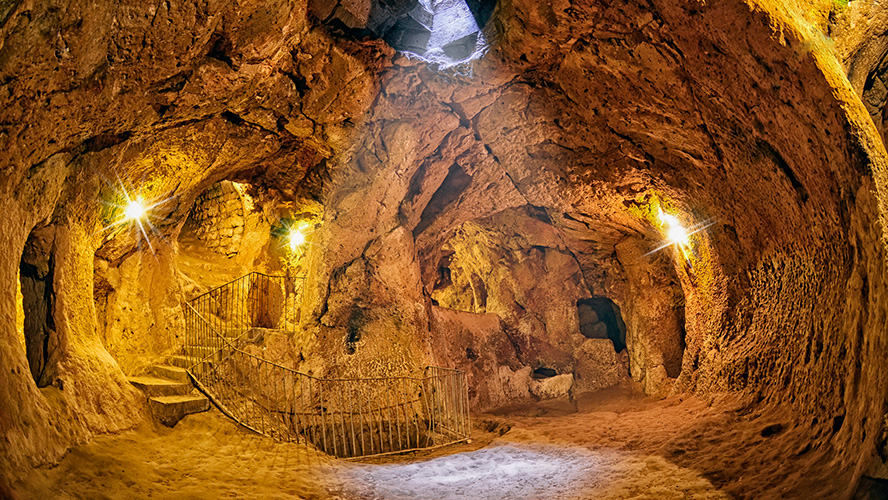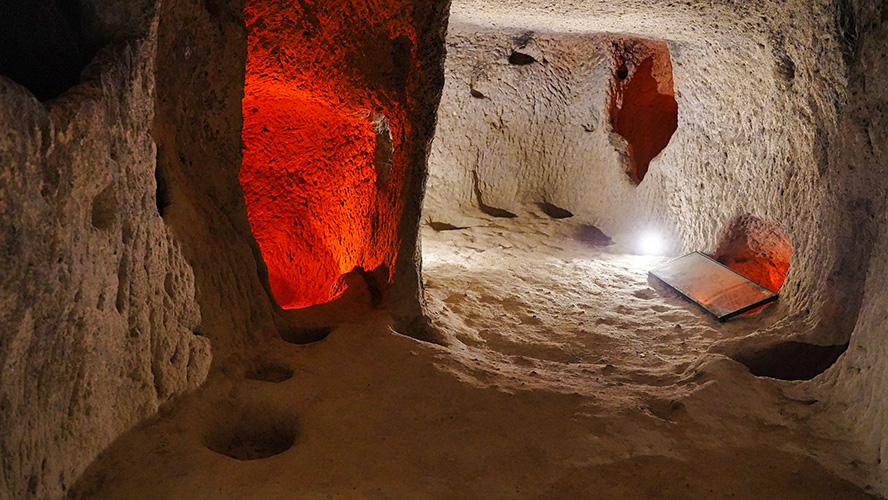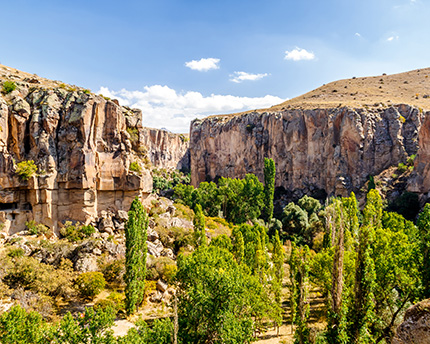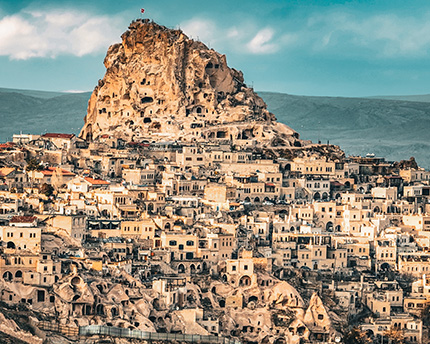The various volcanic eruptions in Cappadocia caused it to have a soft layer called tuff, where you could dig a cave and even dozens of cities, some with a capacity of almost 20,000 inhabitants, such as Derinkuyu.
History of the underground cities
Some studies explain that the first underground caves and shelters began to be built in the Hittite period, i.e. around 2000 BC, when they were attacked by the Phrygians. However, the underground cities as we know them today were created following the flight of the first Christians in the Roman Empire when they began to be persecuted because of their religion and the Phrygian culture evolved into Greek.
In this case, they preferred to hide underground, where they kept their faith and their churches, to avoid being annihilated by the Romans and took advantage of the malleability of tuff, the material that had formed in the area after volcanic eruptions, to create true civilisations underground near the town of Göreme, which was a magnet for the followers of Christ.
It is said that there may be as many as 200 underground cities in the entire region, although only about 36 have been rediscovered in recent years. Most of them have specific levels for livestock, water wells and ventilation places so that the inhabitants could survive for several months underground.
In fact, they were used until 1923 when the Greeks were expelled from Turkey and many of these dwellings were abandoned until they fell into oblivion.
Derinkuyu underground city
Derinkuyu is the largest underground city still preserved today with more than 85 metres underground, reaching 20 levels in some sections. In total, the ancient city of Elengubu, as Derinkuyu was known, covers 445 square kilometres.
This settlement, which once housed 20,000 people, was inhabited for thousands of years by the Phrygians, Persians, Christians and Muslims, and was not completely abandoned until 1923 with the departure of the Greeks from Cappadocia.
For decades it fell into oblivion until work on a house in the village exposed a labyrinth of tunnels that led to the discovery, once again, of an entire city.

It is not clear when Derinkuyu was first built, but there are written references as early as 370 BC.
The city’s structure provided an area for the stables that was closer to the surface to avoid the toxic gases from the animals and also to create a warm layer to reduce the cold of the more subterranean levels.
The city had more than 50 ventilation shafts and natural light sources to ensure oxygen at a depth of 55 metres, which could be covered from below with huge millstones. It also had a system of water wells. Facilities such as ovens, churches, children’s schools and bars have been preserved to this day.
Kaymakli underground city
Kaymakli is one of the best preserved underground cities. It dates from the same period as Derinkuyu and is even believed to have been connected underground by a system of tunnels.
It was built by the Phrygians, who gradually changed their language to Greek, and inscriptions have been found in one of the large churches built underground.
The chambers in this city follow the same structure as other underground cities. In this case, it has eight levels but only four can be visited, and it housed some 3,500 people in its heyday.

Ventilation shafts create a kind of air-conditioning system to control the air and temperature in the dwellings while stables on the first level and storage areas for pots have been found on several floors next to the kitchens and water wells.
A very curious aspect is the burial chambers inside the city walls that were used to bury the dead and the system of enclosing them with huge stones that could only be opened from the inside.
Tips and information for visitors
Remember that some of the areas in Cappadocia’s underground cities are narrow and can be claustrophobic so, if you have a fear of confined spaces, do not try this. Otherwise, do not worry because there are plenty of areas to rest that are quite spacious and ventilated. Make sure that you arrive as early as possible to avoid long queues.
In both cities, there are marked routes and it is advisable to stay on them since they are equipped to avoid accidents. You should also go with a torch in case you cross poorly lit areas, and always watch where you are going.
Many of the areas along the route have uneven ground or water seepage, so it is advisable to wear shoes that are well fastened to avoid slipping.
Since the rooms in these cities are underground, they are quite cool and damp, so you should wear a jacket even in summer so that you do not get cold and the visit is pleasant.
All the guides insist that this World Heritage Site must be cared for so that it can be visited and enjoyed by future generations, so they strongly urge that nothing be written or engraved on its walls.


































































